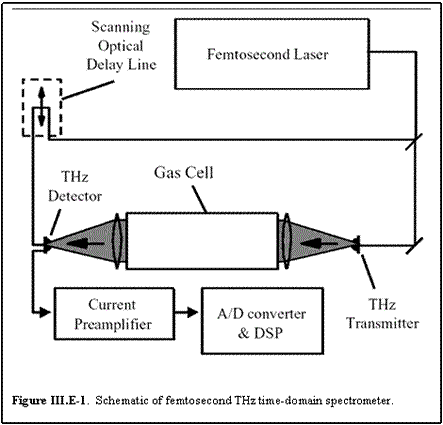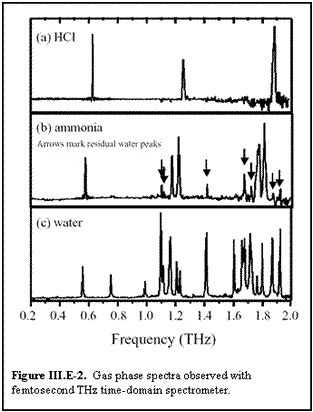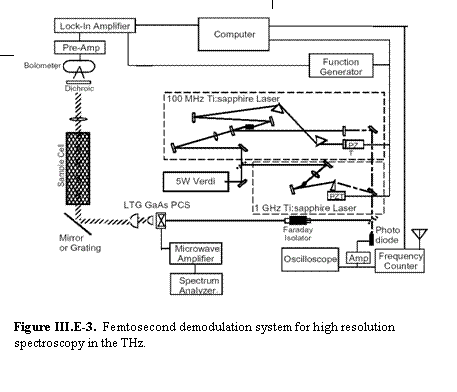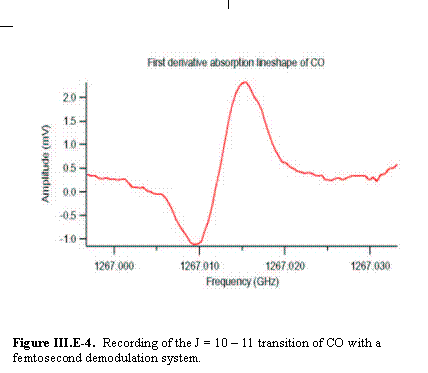
E. Femtosecond Sources:
All THz sources depend in one way or another on the production of current pulses whose time scale is of the order of the reciprocal of the frequency being generated. Since the reciprocal of 1 THz is 1ps, it is natural to turn toward femtosecond lasers as a driving source for these current pulses. Two general schemes have evolved: one of which uses the femtosecond pulse to generate a broad spectral pulse and Fourier Transform techniques similar to those employed in FT-FIR systems are used to achieve spectral resolution; and another which uses a train of femtosecond pulses to produce a high resolution comb of frequencies which is tuned by scanning the mode-lock frequency of the drive laser. Both use photoconductive switches to demodulate the optical pulse to provide the THz radiation.1

Figure III.E-1 shows an example of the former.2 In this system the laser beam is split into two parts. The first drives the transmitter switch and the second, which passes through a variable delay line, drives the detector switch. Since this detection process is coherent, the Fourier Transform of the detector output as a function of delay time results in the spectrum of the gas sample. Figure III.E-2 shows an example of spectra which result.2 ,3 (2) (3)

Higher resolution than the ~1 x 10-2 – 1 x 10-3 shown can be achieved by use of a lower pressure gas and a longer scan in the delay line, although at the expense of signal strength as a smaller fraction of the THz pulse interacts with the sample. Figure III.E-3 shows an example of a system based on the demodulation of a train of femtosecond pulses.4,5 (4) (5) The train of pulses on the photoconductive switch produces a comb of THz frequencies, separated by the mode- lock frequency. Portions of this comb are selected by passive THz components such as gratings and filters and the frequency of the source is continuously tuned by scanning the mode-lock frequency of the drive laser.6 Figure III.E-4 shows an example of a spectral line measured with this system. This system provides absolute frequency calibration via electronic counting of the mode-lock at a convenient microwave frequency and very high spectral purity because it is based on a multiplication of a base microwave frequency rather than the difference between large optical frequencies.  Measurements have shown a spectral purity of ~3 x 10-8. More recently, this comb of frequencies has also been used for absolute frequency measurement in the optical.8
Measurements have shown a spectral purity of ~3 x 10-8. More recently, this comb of frequencies has also been used for absolute frequency measurement in the optical.8

References
[1] D. H. Auston, K. P. Cheung, and P. R. Smith, "Picosecond photoconductive hertzian dipoles," Appl. Phys. Lett., vol. 45, pp. 284-286, 1984.
[2] D. M. Mittleman, R. H. Jacobsen, R. Neelamani, R. G. Baraniuk, and M. C. Nuss, "Gas Sensing with Terahertz Time-Domain Spectroscopy," Applied Physics B, vol. 67, pp. 379, 1998.
[3] R. H. Jacobsen, D. M. Mittleman, and M. C. Nuss, "Chemical Recognition of Gases and Gas Mixtures using Terahertz Waveforms," Optics Letters, vol. 21, pp. 2011, 1996.
[4] F. C. De Lucia, B. D. Guenther, and T. Anderson, "Microwave Generation from Picosecond Demodulation Sources," Appl. Phys. Lett., vol. 47, pp. 894-896, 1985.
[5] T. M. Goyette, W. Guo, F. C. De Lucia, J. Swartz, H. O. Everitt, B. D. Guenther, and E. R. Brown, "Femtosectond Demodulation Source for High Resolution Submillimeter Spectroscopy," Appl. Phys. Lett., vol. 67, pp. 3810, 1995.
[6] J. R. Demers and F. C. De Lucia, "Modulating and Scanning the Mode-lock Frequency of an 800 MHz Femtosecond Ti:Sapphire Laser," Opt. Lett., vol. 24, pp. 250-252, 1999.
[7] J. R. Demers, T. M. Goyette, K. B. Ferrio, H. O. Everitt, B. D. Guenther, and F. C. De Lucia, "Spectral Purity and Sources of Noise in Femtosecond-Demodulation THz Sources Driven by Ti:Sapphire Mode-Locked Lasers," IEEE J. Quant. Electron., vol. 37, pp. 595-605, 2001.
[8] S. A. Diddams, D. J. Jones, J. Ye, S. T. Cundiff, J. L. Hall, J. K. Ranka, R. S. Windeler, R. Holzwarth, T. Udem, and T. W. Hansch, "Direct Link between Microwave and Optical Frequencies with a 300 THz Femtosecond Laser Comb," Phys. Rev. Lett., vol. 84, pp. 5102-5105, 2000.